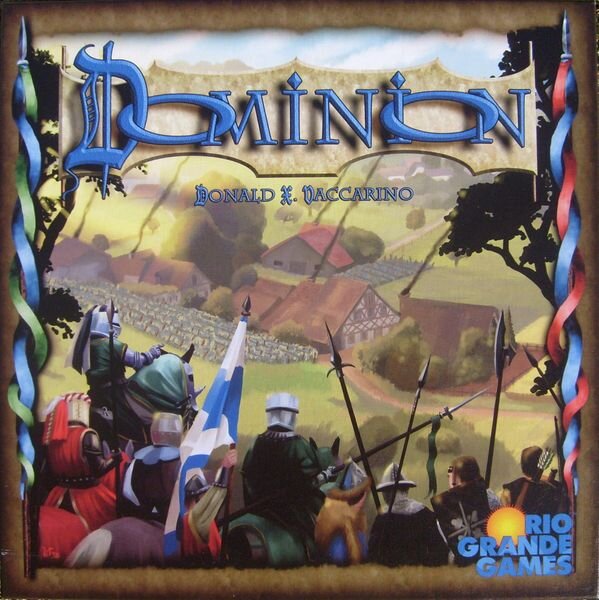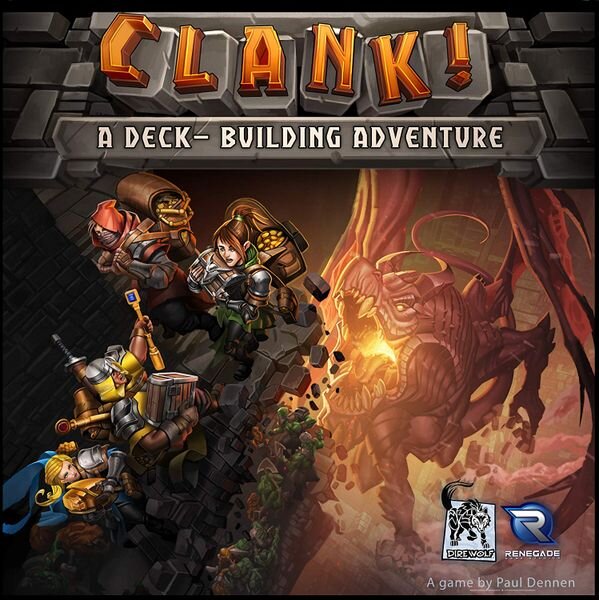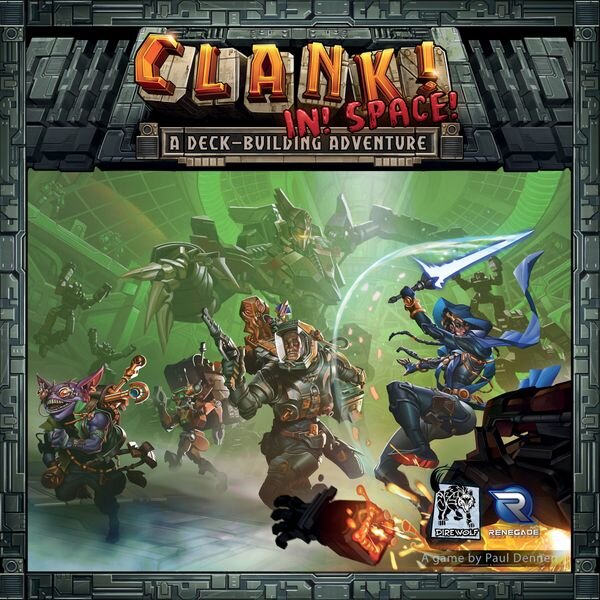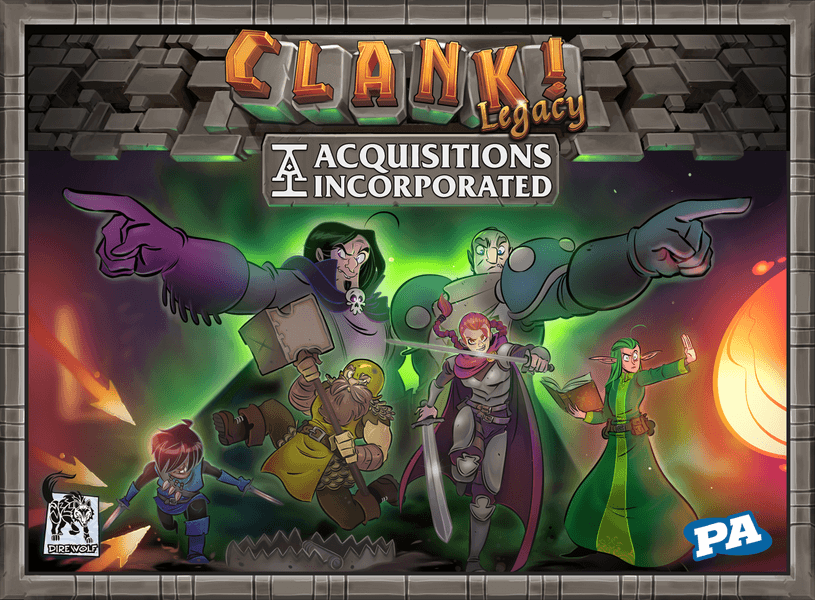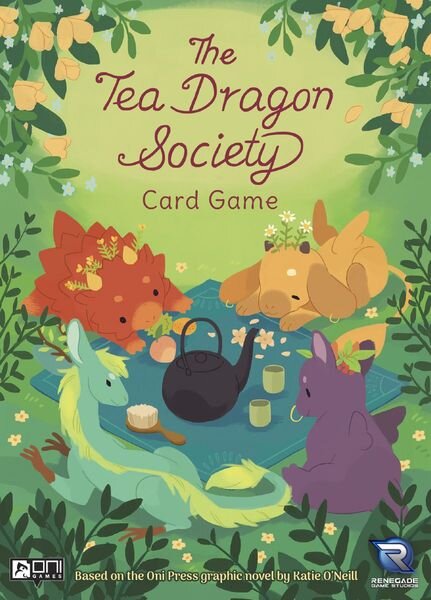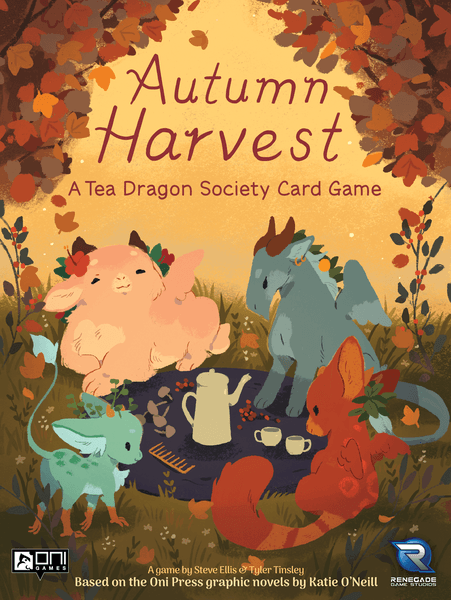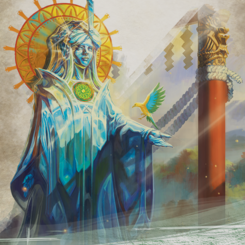18 Deckbuilding Games Worth Your Consideration
What is a deckbuilding game? It’s a game where you start with a deck of simple, weak cards, and over the course of the game, you buy new cards that are shuffled into your deck. By the end of the game, you’ll have a customized deck where each hand of cards that you draw will (hopefully) be significantly more powerful than the ones you started with. This genre was first popularized by Dominion in 2008, and has really taken off in the past 15 years. Nowadays, there are a ton of awesome deckbuilding games to choose from. Here are some of my favorites, in no particular order!
What is a deckbuilding game? It’s a game where you start with a deck of simple, weak cards, and over the course of the game, you buy new cards that are shuffled into your deck. By the end of the game, you’ll have a customized deck where each hand of cards that you draw will (hopefully) be significantly more powerful than the ones you started with. This genre was first popularized by Dominion in 2008, and has really taken off in the past 15 years. Nowadays, there are a ton of awesome deckbuilding games to choose from. Here are some of my favorites, in no particular order!
Dominion
The original deckbuilder, and still probably the purest example of the genre. Pretty much all the other deckbuilders on the market can trace their lineage directly back to Dominion. It's very accessible, even to non-gamers, and the modular setup combined with a plethora of expansions means that it has tons of replay value.
Fun fact: Dominion can be played online for free at https://dominion.games/.
Ascension
Ascension was one of the earliest deckbuilding games to hit the market after Dominion first introduced the genre to the market. It features two currencies rather than Dominion's one: runes are used to buy new cards for your deck, while power is used to defeat monsters for points and one-shot bonuses. Since its original release, it's received lots of expansions, most of which also function as standalone base games in their own right.
I actually don't like the original core game all that much by itself. It's fine, I guess. However, I do like it with expansions. My favorite is Ascension: Realms Unraveled.
Valley of the Kings
In Valley of the Kings, you are a mighty pharaoh ruling over Egypt, and at the end of the game, you die. But here's the good news: whatever wealth and riches are entombed with you in your pyramid will remain with you in the afterlife! It turns out you can take it with you. Of course, if you bury all your stuff now, you won't be able to enjoy it while you're alive. Hmm. Decisions, decisions.
This game is a delicate balance between keeping cards in your deck, where you can benefit from their effects, and entombing cards in your pyramid, where they will score points at the end of the game. Any cards that you fail to entomb before the deadline are worth nothing, so knowing when to pivot from collecting more treasures to burying them away is key. It's a nice little wrinkle on the formula, and it plays well.
There were originally three different standalone variants of the game. I have Valley of the Kings: Afterlife (the second of them) in my personal collection, and I like that it all fits in a tiny little box. However, the big-box Premium Edition collection, which includes all three expansions plus bonus content, and uses deluxe tarot-size cards. On the one hand, portability...on the other hand, more content. It would be a tough decision, except the smaller individual editions are now out of print. So, for new buyers, it'll probably be the big box!
Mystic Vale
Now here's a unique take on the genre. Instead of adding cards to your deck, you add abilities to your cards! The gimmick is, all the cards come in sleeves, and the upgrades for them are printed on clear plastic. So you slide the upgrade into the sleeve and it occupies one of three upgrade slots on that card.
It's a neat gimmick, and the game underneath it is also neat. In addition to deckbuilding, there's a major push-your-luck element to it: you can draw any number of cards on your turn...if you dare. But as soon as you flip over four of the little red symbols, your harvest spoils, and you discard everything and skip the rest of your turn.
I like Mystic Vale. It is a good game. I've played the base game quite a lot, and now I'm at the point where I've seen all the cards and I'm ready to mix in an expansion.
Clank!
In Clank!, players are adventurers delving into a dungeon, trying to grab as much treasure as they can carry and then get out before the dragon wakes up and eats them. It's a wonderful combination of deckbuilding plus old-school movement around a board, topped off with a slice of push-your-luck to give it that extra zing.
The deckbuilding mechanics in Clank! are reminiscent of Ascension, with one currency (blue) used to purchase cards to add to your deck and another (red) used to fight monsters for one-time benefits. But there's also a third currency (yellow), which is used to move your token around the map. As you move through the dungeon, you'll explore rooms, finding treasure (some of which is fixed, some of which is randomized) and fighting your way past guards and hazards. The deeper you delve, the more points you can earn—but the farther you stray from the safety of the surface, the more likely it is that the dragon will find and carbonize you before you have time to make it out again.
Over the course of the game, players will make noise, represented by color-coded Clank! cubes that are added to a bag. Every so often, the dragon will attack, and a number of Clank! cubes will be drawn at random from the bag. If they show your color, you take damage. Too much damage and you die, which usually means you lose. In other words, you'll want to avoid making noise—or trick your opponents into making more noise than you.
I like Clank! because of how seamlessly it blends its different mechanisms into a fun and story-rich gaming experience. Once the first player dies or escapes the dungeon, an end-of-game countdown starts, which means the game tends to run at a fast pace, rarely overstaying its welcome. I appreciate that. The base game has plenty of variety in it, including two different boards, but there are also quite a few expansions that can increase longevity even further. My biggest complaint is that it takes a little while to find and set up all the tokens and fiddly bits on the board at the start.
Clank! In! Space!
It's Clank!, but in space!
Okay, it's not exactly like the original. Besides being re-themed, Clank! In! Space! has a few extra mechanisms that make it a slightly different experience. The biggest change is that you have to explore more of the map and complete an extra objective before you're able to escape from the evil Lord Eradikus's spaceship with your ill-gotten goods. This means games will tend to run longer, which, depending on your preference, might be good or bad. For me, I prefer the more streamlined pace of the original, but I know some people like to linger more and savor the expensive cards they've bought for their endgame deck.
Either way, can't go wrong, they're both great.
Clank! Legacy: Acquisitions Incorporated
It's Clank! as a legacy game. What more do I need to say? Clank! is awesome, and legacy games are...well, they're not for everyone, but for the people they are for, they're awesome. So, put the two together, and they're awesome together.
You do kinda need a dedicated group to run through the campaign; you can't really pull it out for just one night and then forget about it afterwards. I mean, you can, but...you know what I mean.
The Quest for El Dorado
The Quest for El Dorado is similar to Clank! in that it combines deckbuilding with movement on a board. I'd venture to say that if you like one, you'll almost certainly like the other, as they're both excellent games.
In this one, it's a race rather than a dungeon crawl. Instead of delving into a dragon's lair in search of loot, you'll play cards to move your explorer through the hex map of the South American jungle in search of the Golden City. But be quick, because everyone else is searching for it as well. First one to find El Dorado wins!
I haven't personally played this one, but I have read the rulebook, and it seems very robust. And of course, it's just swimming in glowing reviews and general critical acclaim. Currently, The Quest for El Dorado sits near the top of my list of Games I Really Want To Play But Haven't Been Able To Yet.
The Tea Dragon Society Card Game
These are two variants of the same game; if you have both, you can combine them together. Both games are incredibly adorable, featuring beautiful illustrations based on the Tea Dragon Society graphic novel.
Unlike most deckbuilding games, you have no hand of cards here. On your turn, you either flip a card from your deck directly into play, or you discard cards from play to purchase a new card. It's a style of gameplay that is simple, fast-paced, and relaxing. The mechanics also do a wonderful job of capturing the feel of the book the game is based on.
Of the games on this list, I think this is one of the most accessible to non-gamers, both because of its simple rules and its appealing aesthetics. And if you're a fan of the franchise, it's a must-have.
Lost Ruins of Arnak
Lost Ruins of Arnak combines deckbuilding with worker placement into a lovely hybrid that ended up being one of the hottest games of 2020, winning a Golden Geek Game of the Year award, a Kennerspiel des Jahres nomination, and a pack of other nominations.
Players are brave explorers in a pulp adventure setting, searching for the eponymous ruins. On your turn, you can play an action card from your hand to gain its effect or place your archaeologist on one of the spaces on the board to gain its effect. There are lots of ways to earn points, and whoever has the most points at the end of five rounds wins the game.
This is just a really well-executed game on basically all fronts. The gameplay is great, the art is great. It is on the moderately complex side—there are a lot of moving parts—but if you've played deckbuilding games and worker placement games before, that foundation should make Lost Ruins of Arnak a breeze to learn. (Also, the rulebook is well-written, which helps a lot.)
I would definitely recommend giving Lost Ruins of Arnak a try if you are a board game hobbyist. You can try a digital version for free at https://en.boardgamearena.com/gamepanel?game=arnak. For less experienced players, The Quest for El Dorado might be a better place to start; it has similar themes and mechanics, but it's simpler and more accessible.
Shadowrun: Crossfire
Shadowrun: Crossfire is a cooperative deckbuilding game (in the Shadowrun universe), except it's played in a campaign, so you can gain permanent upgrades. Like, you put stickers on the cards. It's a legacy game. I think that's really neat.
Of course, this means it comes with all the usual upsides and downsides of campaign-style games—most notably that you really need a consistent group that will meet on a regular basis to play it. If you can swing that, it'll probably be awesome, because you'll get to tell a story through the missions, and level up, and stuff! And it has a lot of content! It's the sort of board game that you can treat almost like a tabletop RPG. In fact, they even came out with a Dungeons & Dragons variant of it called Dragonfire. I think this concept works great in the Shadowrun universe, though. If anyone needs a player for a Shadowrun: Crossfire campaign, hit me up.
Dice Forge
In Dice Forge, players are heroes trying to impress the gods by completing awesome feats of heroism! Everyone starts with two humble dice with modular faces. Over the course of the game, you'll upgrade your dice by physically exchanging the existing faces for new, more powerful ones, LEGO-style. Each roll of the dice grants you resources which can help you complete heroic quests to gain treasure and glory.
I love this game. Love it to pieces. First off, it's gorgeous. All the components are great quality with beautiful illustrations in a charming and colorful aesthetic. Secondly, the tactile feel of prying a face off of your die and clicking the upgraded face in its place? Unparalleled. Third, the gameplay holds up! It holds up really well! The game is fun, with a healthy enough mix of strategy and luck that you can feel like you're in control of your gameplan while also being surprised at what happens next. And the modular setup provides replay value: there are two sets of cards that you can mix and match or move around. And, like, it's just a really strong, polished experience, like, overall.
The Dice Forge: Rebellion expansion adds tons more content too, unlocking more options and new advanced strategies.
And yes, it's a dice-building game, not a deckbuilding game. But look, they're the same thing, okay? Shut up. It's great.
Direwild
Okay. Imagine. Dungeons & Dragons...meets Pokémon...as a deckbuilding game. That's Direwild in a nutshell.
It's a fully cooperative hybrid of deckbuilding and dungeon-crawling. You're fighting monsters as a team, but you're also capturing monsters and recruiting them onto your side.
Anyway, I'm not really a co-op gamer, and I haven't played Direwild yet. But I gotta give 'em props for the high concept. It sounds cool, right?
The Red Dragon Inn: Battle for Greyport
Battle for Greyport is a cooperative deckbuilding game based on the world of The Red Dragon Inn. The city is under attack by monsters and pirates, and you and your friends must defend it!
I haven't played this one yet, but I heard that it's tough as nails. You'll play through a scenario and recruit heroes and buy items and all that jazz, except monsters are going to be hitting you in the face while you're doing it, and if anyone drops to 0 HP, the whole team loses. If you like the idea of teaming up with your friends instead of squabbling amongst one another, or even playing solo (which is a thing you can do here), this might be the deckbuilder for you. Just be ready to die.
The Quacks of Quedlinburg
It's a bag-building game, but, you know, same thing. You're stashing chits in your bag to pull out later and add to your pot. Depending on the tiles you draw, your potion might be worth more points—but if you push your luck too far, the whole brew will explode.
The Quacks of Quedlinburg attracted a lot of buzz and critical acclaim when it was released, and it won a bunch of awards, including a Golden Geek, an Origins Award, the 2018 Kennerspiel des Jahres, and more. It's another one that I hope to have the chance to play at some point, although that time has not yet arrived.
Black Rose Wars
This is a big game. This is a complex game. It has SO MANY RULES. I tried to read the rulebook and, wow, it's a lot. I think it melted my brain.
There are things I do not like about Black Rose Wars. It is hard to learn and heard to teach. It has a long setup time. The name and box art are pretty, but do a poor job of communicating the game's theme. The art on the board is also pretty, but it's busy and makes the game elements harder to read. A lot of the bits are fiddly. The rulebook is long and sprawling, and there is a conspicuous lack of player aids. There's also a programming aspect to it that I'm ambivalent about—is it meant to represent Vancian casting with prepared spell slots?
On the other hand, there are also some things about this game that I love. First off, all the moving parts mean that there is a ton of depth to the gameplay. There are lots of different strategies to explore, which is great for replayability. I love how it incorporates different decks for different schools of magic, each with their own feel to them—that's an aspect of wizardry from Dungeons & Dragons that doesn't often make it into board games. I like that the Black Rose can give you powerful forbidden spells, but is also effectively a neutral player that will basically explode the whole battlefield and make everyone lose the game if you leave it alone too long. And I like that page 34 of the rulebook has a picture of a demon cosplaying as Mickey Mouse from "The Sorcerer's Apprentice." That's a real thing, it's in there, he has the fake mouse ears and everything, I'm not making that up.
Ultimately I think Black Rose Wars is a great illustration of the old axiom that your greatest weakness is usually your greatest strength pushed too far. This is a really deep, crunchy, strategic game, and that will make it appealing to hardcore board gamers who enjoy deep, crunchy, strategic games. However, it also imposes a high barrier to entry. Many people will bounce off this game. So, there you have it. If it's not for you, it's not for you. But if it is for you, then it might be for you, provided that the rest of your gaming group has similar tastes.
Harry Potter: Hogwarts Battle
I'll be honest, I'm pretty much off of Harry Potter. Every single iteration of the franchise since the main series ended has been garbage in my opinion, and now J.K. Rowling is a TERF? Yeah, I'm out.
But I guess some people still like it, so if you're one of those people, this is a cooperative deckbuilding game that has a Harry Potter theme.
Blank White Dice
Blank White Dice is a dice building game that is smaller and more portable than Dice Forge. I gotta say, though, the production value is definitely a lot lower. It's not nearly as pretty, and the gameplay is fiddlier and...very aggressive, for some reason? There's a lot of stuff that lets you mess with your opponents' dice.
Anyway, this game is pretty good, but in my opinion, it does very much pale in comparison to Dice Forge (even though the gameplay is different enough that it's not reeeally a fair comparison). On the upside, it is also cheaper!
So there you have it! That was 18 deckbuilding games and why they’re worth checking out. At the time of this writing, I believe all of these games are currently in stock, so if any of them sounds good, contact us and we can reserve you a copy!
Do you have a favorite deckbuilding game that isn’t listed here? If so, let us know in the comments!
Superfight
Superfight is a game where you argue over who would win in a fight. And it’s hilarious. Each player has a character card (such as Zombie, Pirate, Kindergarten Class, or Abraham Lincoln) and some number of modifier cards (such as 10 Stories Tall, Hands are Covered In Butter, Armed With a Shotgun, or Horrible Self-Esteem), not all of which are under your control. Once all contestants have chosen their fighters, you have to argue to the judge(s) why yours would be the winner!
Superfight is a game where you argue over who would win in a fight. And it’s hilarious. Each player has a character card (such as Zombie, Pirate, Kindergarten Class, or Abraham Lincoln) and some number of modifier cards (such as 10 Stories Tall, Hands are Covered In Butter, Armed With a Shotgun, or Horrible Self-Esteem), not all of which are under your control. Once all contestants have chosen their fighters, you have to argue to the judge(s) why yours would be the winner!
There are multiple game modes, including a head-to-head between two fighters with all other players as neutral judges, a battle royale where one player is the judge and all other players’ fighters duke it out in a free-for-all, and a villain mode where the judge presents a villain and everyone else must argue why their challenger would be the best at defeating them.
Need more action? We also stock a plethora of expansions, including:
The Purple Deck: This deck adds wacky scenarios and modifiers to the whole fight, like Land Mines or Kitten Stampedes.
The Blue Deck: This deck adds location cards that determine the arena for your battles! Who will have the edge if the fight takes place at a comic book convention?
The Challenge Deck: Bored of fighting the same old fights? With the Challenge Deck, your fighters can instead compete in sporting events, elections, and more.
The Red Deck: This expansion is full of new cards that are raunchy, offensive, and intended for mature audiences only.
The Green Deck: This expansion is wholesome, clean, and family-friendly, featuring food-based weaponry, cartoon characters, fairy tales, and more.
The Orange Deck: While the core set sticks mostly to generic concepts and historical and public domain characters, the Orange Deck goes nuts with cards that reference geeky pop culture.
The Anime Deck: Turn your battles into anime battles as your fighters unleash secret forbidden techniques, emotional flashbacks, and more. This deck also features popular anime characters such as Ash Ketchum, Sailor Moon, and Goku.
Dungeon Mode: This new game mode has your fighters battle their way through a deadly dungeon full of traps and monsters. One by one, you’ll fall to the dungeon’s hazards until just one brave explorer escapes with the treasure.
The Mythology Deck: This expansion includes all sorts of characters and tropes from mythology, including gods, heroes, and more.
The History Deck: Battle with famous historical figures, weapons, locations, scenarios, and more! Who would win, Alexander Hamilton Leading 300 Spartans, or Vlad the Impaler Manning a Civil War Cannon?
The Sword & Sorcery Deck: This expansion is based on high fantasy pop culture. Who would win, Gandalf or The Night King? What about if The Night King has a bag of healing potions and Gandalf is dating the GM?
…and more!
Terror Below
Terror Below has you racing around the Arizona desert collecting giant sandworm eggs while avoiding being eaten by the fully-grown specimens. If you're feeling adventurous, you can also try and fight the sandworms for even greater rewards.
Terror Below has you racing around the Arizona desert collecting giant sandworm eggs while avoiding being eaten by the fully-grown specimens. If you're feeling adventurous, you can also try and fight the sandworms for even greater rewards.
Over the course of the game, you’ll move your car around the board, picking up rubble and eggs and delivering them to various drop-off points in order to earn bonuses and complete quests. The sandworms will move around underneath the board too, drawn to the tremors left by the vehicles zooming around above them, until eventually…they strike! If you’re caught in their attack radius when they do, you’d better hope you’ve collected enough weapons to fight them off, or your character may be facing a grisly demise…unless, at the last minute, you’re able to divert it towards another player!
This game boasts a delightful art style, high-quality components, strategic gameplay, and even a solo mode so that you can play on your own if you’re stuck at home without any friends to game with.
Cartooner/Mangaka
A game about drawing comics! The way it works is you deal out cards from the deck and draw comics based on the prompts you get. The game is played over several rounds, with the rules changing each round as new trends sweep through the comics industry, so in one round you might get points for working in a romantic subplot, while in the next, you might get points based on how many of the characters you can kill off.
A game about drawing comics! The way it works is you deal out cards from the deck and draw comics based on the prompts you get. The game is played over several rounds, with the rules changing each round as new trends sweep through the comics industry, so in one round you might get points for working in a romantic subplot, while in the next, you might get points based on how many of the characters you can kill off.
I love this game because of the hilarious absurdity that you get when you try to somehow mash everything into a coherent story in just a few panels. It works with a group of any size—you can play with a party of ten people, or do a solo run and try for a high score to practice your drawing skills. Best of all, your actual skill with a pencil has no effect whatsoever on your score! It's your creativity that counts, even if the best you can do is a stickman.
(The difference between the two is that Mangaka is about drawing Japanese-style manga, while Cartooner focuses more on American-style comics. Other than that, the rules are the same.)
Legend of the Five Rings
Legend of the Five Rings: The Card Game is a Living Card Game set in the world of Rokugan, the original setting for the Legend of the Five Rings collectible card game.
Welcome to the realm of Rokugan: a land of samurai and mystics, mad dragons and divine beings — a land where honor is stronger than steel. Here, the clans serve the Emperor and engage in courtly deceptions and power plays, even as they wage war against each other and the evil forces that plague their realm. This is the world of Legend of the Five Rings!
Legend of the Five Rings: The Card Game is a Living Card Game set in the world of Rokugan, the original setting for the Legend of the Five Rings collectible card game. To play a Living Card Game, players create individual decks of cards from a base game with a fixed set of cards; they can then add supplemental card packs to this game world, with each pack also having a fixed set of cards, in order to vary their game experience.
While the connection of Legend of the Five Rings: The Card Game to Rokugan and the Colonies — as well as its pervasive themes of honor, nobility, magic, intrigue, duty, and warfare — should carry over from the original L5R CCG, Legend of the Five Rings: The Card Game is not compatible with that original game and will feature significant changes in the game mechanisms.
The first Dynasty Pack in Legend of the Five Rings: The Card Game, Tears of Amaterasu features three copies of twenty new cards and expands on the theme found in the Core Set of the game. Offering new tools for all seven clans as well as new neutral cards to supplement any deck, Tears of Amaterasu is the perfect next step for Legend of the Five Rings: The Card Game.
Terraforming Mars
In Terraforming Mars, you play one of those corporations and work together in the terraforming process, but compete for getting victory points that are awarded not only for your contribution to the terraforming, but also for advancing human infrastructure throughout the solar system, and doing other commendable things.
In the 2400s, mankind begins to terraform the planet Mars. Giant corporations, sponsored by the World Government on Earth, initiate huge projects to raise the temperature, the oxygen level, and the ocean coverage until the environment is habitable. In Terraforming Mars, you play one of those corporations and work together in the terraforming process, but compete for getting victory points that are awarded not only for your contribution to the terraforming, but also for advancing human infrastructure throughout the solar system, and doing other commendable things.
The players acquire unique project cards (from over two hundred different ones) by buying them to their hand. The projects (cards) can represent anything from introducing plant life or animals, hurling asteroids at the surface, building cities, to mining the moons of Jupiter and establishing greenhouse gas industries to heat up the atmosphere. The cards can give you immediate bonuses, as well as increasing your production of different resources. Many cards also have requirements and they become playable when the temperature, oxygen, or ocean coverage increases enough. Buying cards is costly, so there is a balance between buying cards (3 megacredits per card) and actually playing them (which can cost anything between 0 to 41 megacredits, depending on the project). Standard Projects are always available to complement your cards.
Your basic income, as well as your basic score, is based on your Terraform Rating (starting at 20), which increases every time you raise one of the three global parameters. However, your income is complemented with your production, and you also get VPs from many other sources.
Each player keeps track of their production and resources on their player boards, and the game uses six types of resources: MegaCredits, Steel, Titanium, Plants, Energy, and Heat. On the game board, you compete for the best places for your city tiles, ocean tiles, and greenery tiles. You also compete for different Milestones and Awards worth many VPs. Each round is called a generation (guess why) and consists of the following phases:
1) Player order shifts clockwise.
2) Research phase: All players buy cards from four privately drawn.
3) Action phase: Players take turns doing 1-2 actions from these options: Playing a card, claiming a Milestone, funding an Award, using a Standard project, converting plant into greenery tiles (and raising oxygen), converting heat into a temperature raise, and using the action of a card in play. The turn continues around the table (sometimes several laps) until all players have passed.
4) Production phase: Players get resources according to their terraform rating and production parameters.
When the three global parameters (temperature, oxygen, ocean) have all reached their goal, the terraforming is complete, and the game ends after that generation. Count your Terraform Rating and other VPs to determine the winning corporation!


